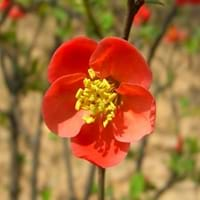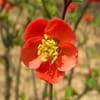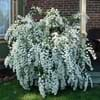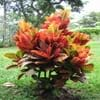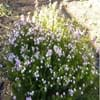Life Span
Perennial
Perennial
Origin
Hybrid origin
Northeastern United States, Mid-Atlantic United States, Southeastern United States, North-Central United States, Central United States, South-Central United States
Types
Japonica , Speciosa , Superba
Apricot Delight, Copper canyon
Number of Varieties
Not Available
Habitat
low mountains, Lower slopes, Screen Cottage and Informal Garden
Roadsides, sand dunes, Waste areas
USDA Hardiness Zone
5-9
5-8
Sunset Zone
2a, 2b, 3a, 3b, 4, 5, 6, 7, 8, 9, 10, 11, 12, 13, 14, 15, 16, 17, 18, 19, 20, 21, 22, 23
1a, 1b, 2a, 2b, 3a, 3b, 4, 5, 6, 7, 8, 9, 10, 11, 12, 13, 14, 15, 16, 17, 18, 19, 20, 21, 22, 23, 24
Habit
Oval or Rounded
Clump-Forming
Flower Color
Orange, Orange Red
Yellow
Flower Color Modifier
Not Available
Bicolor
Fruit Color
Lemon yellow, Light Yellow Green, Yellow Orange
Tan
Leaf Color in Spring
Green, Dark Green
Green
Leaf Color in Summer
Green, Dark Green
Green
Leaf Color in Fall
Green, Dark Green
Green
Leaf Color in Winter
Not Available
Light Green
Leaf Shape
Ovate elongated
Oblong
Plant Season
Spring, Fall
Summer
Sunlight
Full Sun, Partial Sun, Partial shade
Full Sun, Partial Sun
Growth Rate
Medium
Medium
Type of Soil
Clay, Loam
Loam, Sand
The pH of Soil
Acidic, Neutral, Alkaline
Acidic, Neutral, Alkaline
Soil Drainage
Well drained
Well drained
Bloom Time
Early Spring, Spring, Late Winter
Early Summer, Summer, Late Summer
Tolerances
Drought
Variety of soil types
Where to Plant?
Ground, Pot
Container, Ground, Pot
How to Plant?
Divison, Grafting, Hardwood Cuttings
Divison, Seedlings, Stem Planting
Plant Maintenance
Medium
Low
Watering Requirements
Average Water Needs
Average Water Needs, Do Not over Water, Never Over-water, Requires regular watering, Water more in summer
In Summer
Lots of watering
Lots of watering
In Spring
Moderate
Moderate
In Winter
Average Water
Average Water
Soil pH
Acidic, Neutral, Alkaline
Acidic, Neutral, Alkaline
Soil Type
Clay, Loam
Loam, Sand
Soil Drainage Capacity
Well drained
Well drained
Sun Exposure
Full Sun, Partial Sun, Partial shade
Full Sun, Partial Sun
Pruning
Cut away fading foliage, Prune if you want to improve plant shape, Remove damaged leaves, Remove dead branches, Remove dead leaves
Remove damaged leaves, Remove dead branches, Remove dead leaves, Remove dead or diseased plant parts
Fertilizers
All-Purpose Liquid Fertilizer, Complete balanced fertilizer, Compost
All-Purpose Liquid Fertilizer, fertilize in growing season
Pests and Diseases
Leaf spot
Slugs, Snails
Plant Tolerance
Drought
Variety of soil types
Flower Petal Number
Single
Single
Foliage Texture
Medium
Fine
Foliage Sheen
Glossy
Matte
Attracts
Not Available
Insects
Allergy
Unknown
Abdominal pain, Constipation, Diarrhea, Skin irritation
Aesthetic Uses
Beautification, Ornamental use, Showy Purposes
Beautification, Borders, Landscape Designing, Showy Purposes
Beauty Benefits
Not Available
Good for skin, Making cosmetics, Stops hair loss
Environmental Uses
Air purification
Air purification, Food for insects, Versatility
Medicinal Uses
No Medicinal Use
Eczema
Part of Plant Used
Not Available
Root
Other Uses
Acts as a natural source of rain water for birds and insects., Beneficial species for attracting pollinators
Decoration Purposes, Medicinal oil, Showy Purposes, Used as Ornamental plant, Used for its medicinal properties
Used As Indoor Plant
No
Yes
Used As Outdoor Plant
Yes
Yes
Garden Design
Cutflower, Feature Plant, Foundation, Hedges, Mixed Border, Topiary, Bonsai, Espalier
Edging, Feature Plant, Groundcover, Mixed Border
Botanical Name
CHAENOMELES 'Orange Delight'
OENOTHERA 'Cold Crick'
Common Name
Japanese Quince , Japonica
Suncups, sundrops
In Hindi
Flowering Quince
Evening Primrose
In German
Flowering Quince
Evening Primrose
In French
Flowering Quince
onagre
In Spanish
Flowering Quince
onagra
In Greek
Flowering Quince
Νυχτολούλουδο
In Portuguese
Flowering Quince
Evening Primrose
In Polish
Flowering Quince
wiesiołka
In Latin
Flowering Quince
vespere Primrose
Phylum
Tracheophyta
Magnoliophyta
Class
Magnoliopsida
Magnoliopsida
Family
Rosaceae
Onagraceae
Genus
Chaenomeles
Oenothera
Clade
Angiosperms, Eudicots, Rosids
Angiosperms, Eudicots, Rosids
Subfamily
Amygdaloideae
Onagroideae
Number of Species
Not Available
Season and Care of Flowering Quince and Evening Primrose
Season and care of Flowering Quince and Evening Primrose is important to know. While considering everything about Flowering Quince and Evening Primrose Care, growing season is an essential factor. Flowering Quince season is Spring and Fall and Evening Primrose season is Spring and Fall. The type of soil for Flowering Quince is Clay, Loam and for Evening Primrose is Loam, Sand while the PH of soil for Flowering Quince is Acidic, Neutral, Alkaline and for Evening Primrose is Acidic, Neutral, Alkaline.
Flowering Quince and Evening Primrose Physical Information
Flowering Quince and Evening Primrose physical information is very important for comparison. Flowering Quince height is 60.00 cm and width 90.00 cm whereas Evening Primrose height is 1.00 cm and width 0.10 cm. The color specification of Flowering Quince and Evening Primrose are as follows:
Flowering Quince flower color: Orange and Orange Red
Flowering Quince leaf color: Green and Dark Green
Evening Primrose flower color: Yellow
- Evening Primrose leaf color: Green
Care of Flowering Quince and Evening Primrose
Care of Flowering Quince and Evening Primrose include pruning, fertilizers, watering etc. Flowering Quince pruning is done Cut away fading foliage, Prune if you want to improve plant shape, Remove damaged leaves, Remove dead branches and Remove dead leaves and Evening Primrose pruning is done Remove damaged leaves, Remove dead branches, Remove dead leaves and Remove dead or diseased plant parts. In summer Flowering Quince needs Lots of watering and in winter, it needs Average Water. Whereas, in summer Evening Primrose needs Lots of watering and in winter, it needs Average Water.
